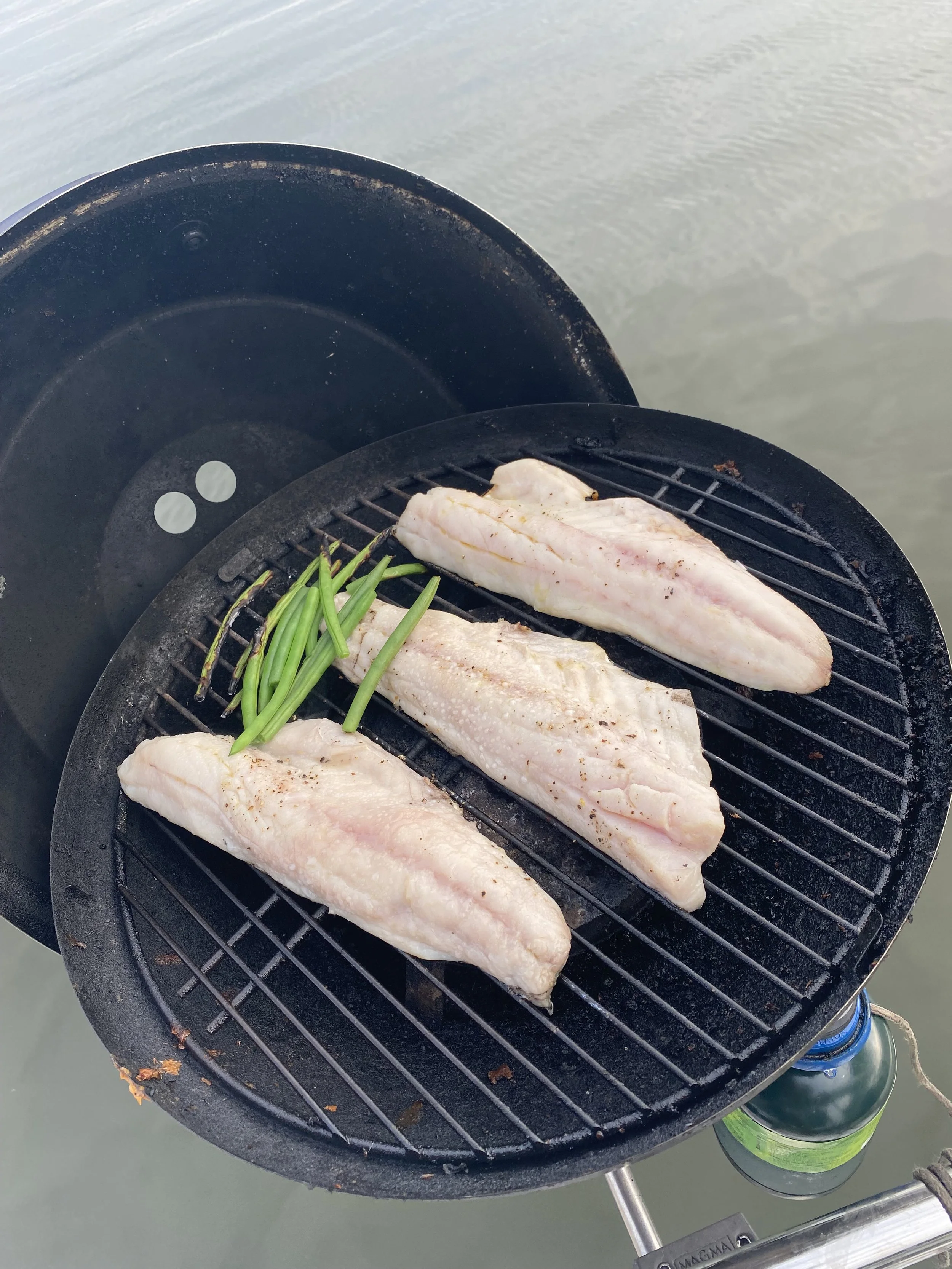Chesapeake Bay Cuisine
The Chesapeake Bay’s bountiful resources have produced its own indigenous cuisine. Chesapeake Bay cuisine refers to the traditional foods and cooking styles found in the Chesapeake Bay region, which encompasses both parts of Maryland and Virginia. The cuisine is known for its use of fresh, local seafood such as oysters, clams, fish and especially blue crab.
Some of the most iconic dishes associated with Chesapeake Bay cuisine include crab cakes, oysters on the half-shell, and rockfish (also known as striped bass). Seafood is a staple of the region's cuisine, and local species like blue crabs, clams, and oysters are often prepared in simple and flavorful ways that showcase their freshness and natural taste. Oysters are also widely used, often in raw or roasted form, or in stews and soups. Rockfish (also known as striped bass) and bluefish are commonly found in Chesapeake Bay cuisine, and are often grilled, baked, or fried.
Another key component of Chesapeake Bay cuisine is the use of crab seasoning. Two of the most iconic seasonings are Old Bay Seasoning and JO Spices. Old Bay seasoning is a blend of spices that includes celery salt, paprika, and black pepper. This seasoning is used to add flavor to a wide range of dishes, including crab, shrimp, and potatoes. JO Spices produce both branded and proprietary spice blends for individual crab houses all around the Chesapeake Bay. Both Old Bay and JO Spices are manufactured in Baltimore, Maryland. If you want to start a robust argument among local crab aficionados. ask which seasoning is better.
In addition to seafood, Chesapeake Bay cuisine also incorporates locally grown produce, such as sweet corn, tomatoes, and okra into its dishes. These ingredients are often incorporated into hearty and flavorful stews, chowders, and salads. Local fruits such as blueberries and watermelons are also widely available.
Overall, Chesapeake Bay cuisine is known for its focus on fresh, seasonal ingredients and its simple, yet bold and flavorful preparations. It is considered a unique and important part of the region's cultural heritage and continues to be enjoyed by residents and visitors alike. If you're a fan of seafood and hearty, down-home cooking, you'll find plenty to love in the foods of the Chesapeake Bay region.
Chesapeake Bay Blue Crab (callinectes sapidus)
The scientific name for the blue crab is Callinectes Sapidus; which literally means Beautiful Savory Swimmer. Anyone who has enjoyed eating any form of the Chesapeake blue crab knows they are sweet and savory.
Chesapeake Bay Blue Crab
Blue crabs are a staple in traditional Chesapeake Bay cuisine and are an important part of the region's cultural heritage. They are highly prized for their sweet and delicate flavor, and are considered some of the best crabs in the world. Dishes like crab cakes, crab soup, sautéed or broiled soft shell, and steamed crab are popular.
Crab cakes are among the most popular traditional dishes featuring Chesapeake Bay crabs. These cakes are made with fresh, steamed crabs that are picked and mixed with breadcrumbs or other binders, spices, and other ingredients, then formed into cakes that are either broiled or fried. They are typically served with tartar sauce, cocktail sauce and a lemon wedge. The competition is fierce for restaurants throughout the Bay as they vie to be recognized for the “best” crab cakes. Among our are favorites are pre-made but uncooked crab cakes from Ford’s Seafood and Chester River Seafood that we broil aboard.
Steamed Blue Crabs
Steamed crabs are another popular dish, where the crabs are simply steamed layered with spices and served with either Old Bay, JO Spice or other seasonings. The crabs are then served with melted butter and/or vinegar for dipping. Corn-on-the-cob, cole slaw, stewed tomatoes and other vegetables are the typical side-dishes. They are often enjoyed as a summertime treat and are typically eaten outdoors with friends and family. Whether enjoyed at a local restaurant or prepared at home, Chesapeake Bay crabs continue to be a beloved and essential part of the region's cuisine. Shardana can sail to several crab houses around the bay or dinghy you ashore for a crab feast on a beach.
Crab imperial is a popular dish made from crab meat mixed with mayonnaise, breadcrumbs, and spices, and then baked. Crab soup is also a staple of Chesapeake Bay cuisine, with crab meat being one of the main ingredients. The two types of soup include a tomato-based “Maryland” style with vegetables like onions, celery, and carrots, as well as spices like thyme, bay leaves, and Old Bay seasoning, and cream of crab so thick it almost seems like a crab dip. If you can’t decide then you can always order “half-n-half.”
Oysters
Chesapeake Bay oysters are harvested from the largest estuary in the United States stretching from southern Virginia to northern Maryland. Chesapeake Bay oysters are known for their plump, creamy flesh and a mild sweet flavor with a slightly salty finish. They are considered to be some of the finest oysters in the world.
Orchard Point Oyster Farm
The Chesapeake Bay is one of the most important oyster-producing regions in the country. The regional season limits wild harvesting to the colder months from October to March, but farm raised oysters are available year-round. Shardana often sails past oyster floats from the Orchard Point Oyster Company on our way up the Chester river to one of the many anchorages on our overnight trips.
Oysters on the Half Shell
Oysters can be enjoyed raw on the half shell, grilled or roasted, or in stews and soups. Oysters are not only delicious, but they also play an important role in the region's ecosystem. Oysters are known for their ability to filter water, and they help to maintain a healthy balance in the Chesapeake Bay by removing excess nutrients and pollutants. A typical Chesapeake Bay oyster can filter 50 gallons of water per day playing an important role in maintaining the health of the Chesapeake Bay. Oyster stew is one of the most popular dishes where the oysters are simmered in a creamy broth with onions, celery, and spices. Oysters Rockefeller, which are baked oysters topped with a mixture of breadcrumbs, spinach, and butter is another popular dish.
Dredging for Oysters
Chesapeake Bay oysters have a long history in the region and are an important part of the local culture and cuisine. During the 1980s disease and overfishing took a dramatic toll on the fishery but through careful management, the introduction of disease resistant strains, and the proliferation of oyster aquaculture, recent harvests have reached 35-year highs. (Read about Shardana’s effort to help with Chesapeake Bay oyster restoration.) Today, they continue to be harvested and enjoyed by residents and visitors alike, and they are a sought-after delicacy in restaurants and markets throughout the region.
RockFish aka Striped Bass
Fresh Caught Rock Fish on the Grill
Chesapeake Bay rockfish, also known as striped bass, is a popular fish species for both recreational and commercial fishing , and it is widely enjoyed as a food fish. The Chesapeake Bay is the largest rockfish breeding ground in the world.
Chesapeake Bay rockfish is prized for its firm, white flesh and mild flavor, which makes it a versatile fish that can be prepared in many different ways. It is commonly grilled, baked, or fried, and it can also be served as a whole fish or filleted. They are also often used in soups, stews, and chowders. Fresh rockfish can be found in many local restaurants and markets. One of Shardana’s favorite recipes is to spread filets with mayonnaise and seasoning, then wrap them in foil before grilling in the cockpit at sunset.
One of the unique features of Chesapeake Bay rockfish is its lifecycle - it is a migratory fish that travels from the ocean up into the Chesapeake Bay to spawn in the spring, making it a seasonal delicacy for local residents and visitors. It is an anadromous fish meaning it spawns in freshwater and heads out to sea to mature.
Like the blue crab and oyster, Chesapeake Bay rockfish have a long history in the region and are important part of the local culture and cuisine. Today, rockfish continues to be harvested and enjoyed by residents and visitors alike.
Smith Island Cake
Smith Island cake is a traditional dessert that is native to Smith Island, which is located on Maryland’s eastern shore of the Chesapeake and is officially considered the state dessert of Maryland. It is a multi-layered cake that is typically made with yellow cake and a rich, creamy frosting, usually made from a mixture of sugar, butter, and milk. The cake is traditionally served in thin layers, with as many as 10 or more layers stacked together, creating a tall and impressive dessert.
Smith Island Cake
What sets Smith Island cake apart from other types of cakes is its use of rich, egg-based batter, which gives the cake its dense, moist texture and a unique creamy, fudgy frosting.
Smith Island cake is often served as a dessert, either on its own or served with a scoop of ice cream or whipped cream. It is also a popular treat for special occasions, such as weddings, birthdays, and holidays, and is often given to friends and family as a way to show affection and hospitality.
Smith Island cake has a long history on Smith Island and continues a rich, decadent treat made by local bakers both on and off Smith Island. Book a 5 day trip on Shardana and you can sail to Smith Island for the freshest seafood and all the cake you can eat.







